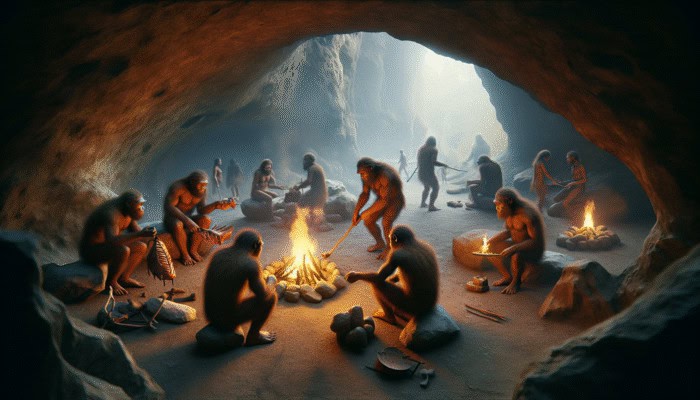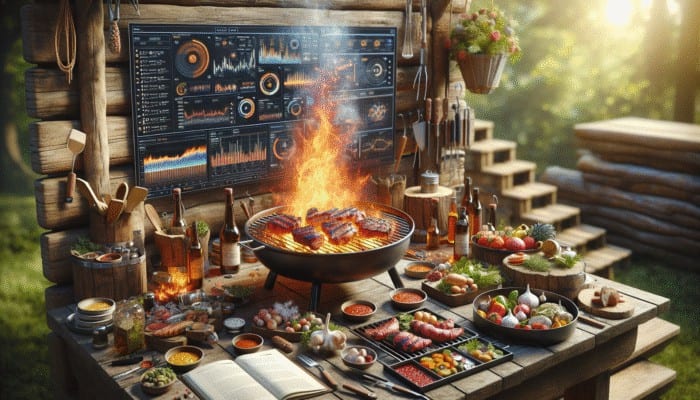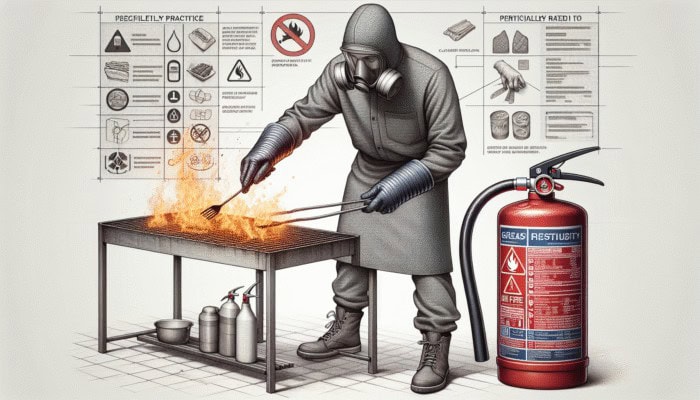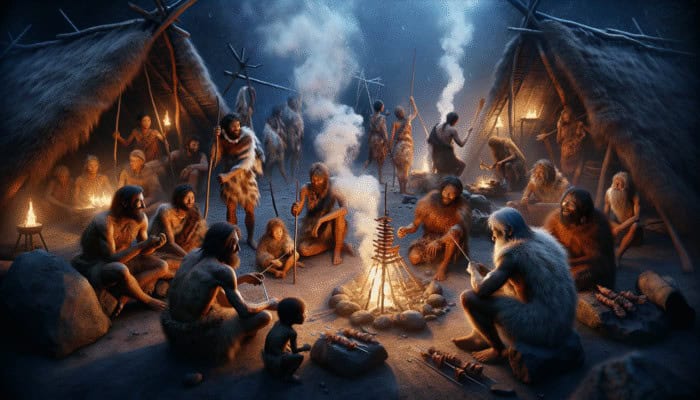Exploring the Rich History of Open-Fire Cooking
Open-fire cooking is deeply rooted in human history, tracing back to prehistoric eras when our ancestors first discovered fire’s transformative potential. This revolutionary breakthrough changed how we prepared food and significantly influenced our biological and social evolution. As early humans learned to harness the power of an open flame, they realised that cooking could improve the safety and flavor of their meals. The enticing smoky aroma and crispy texture associated with food cooked over fire became integral to communal gatherings, fostering a sense of belonging and connection among individuals.
Throughout ancient civilisations, unique fire cooking techniques emerged, shaped by the local resources available to different cultures. For instance, indigenous tribes in the Americas expertly used open flames for grilling and roasting, resulting in dishes celebrating their rich culinary heritage. In contrast, Asian cultures developed distinctive methods, such as tandoori cooking, showcasing local ingredients, and honoring traditional flavours. As societies evolved, so did the art of open-fire cooking, creating a diverse tapestry of global culinary practices that continue to enrich our dining experiences today.
The role of open-fire cooking extends well beyond basic nourishment; it possesses profound cultural significance in numerous societies. For example, family gatherings in Mediterranean regions often center around meals prepared over open flames, symbolising hospitality and togetherness. Similarly, communal cooking methods foster unity and shared experiences in various parts of Africa, as families and friends come together to enjoy the fruits of their labour. The inviting sound of sizzling meat and the warmth of a crackling fire create cherished memories, forging connections that span generations through the timeless art of cooking.
Tracing the Origins of Fire Cooking

The origins of open-fire cooking can be linked to the pivotal discovery of fire itself, a momentous event in the annals of human history. Early hominids, utilising primitive tools, mastered fire control, enabling them to cook their food and enhancing its digestibility and safety. This revolutionary advancement improved nutrition and reshaped social dynamics, as cooking evolved into a communal activity that brought people together. Archaeological evidence from sites like Wonderwerk Cave in South Africa, dating back over a million years, provides insights into early instances of fire use for cooking, underscoring its historical significance.
As fire management techniques progressed, various cooking methods emerged, including roasting, grilling, and smoking. These methods were influenced by geographical factors, with some cultures utilising stones or clay to craft ovens, while others adapted their techniques for portable cooking over open flames. This adaptability reflects the ingenuity of early humans, who learned to work harmoniously with their environment, harnessing available resources to elevate their culinary practices.
The profound impact of open-fire cooking on human evolution cannot be overstated. Cooking over fire provided essential nourishment and played a critical role in cognitive development. The ability to prepare food led to a more varied diet, which is believed to have stimulated brain growth and development. This transformation marked a significant departure from raw food consumption, facilitating the thriving and innovation of early humans as they adapted to their surroundings.
Understanding the Evolution of Cooking Methods
As human societies advanced, so did the methods of open-fire cooking. The initial use of fire for cooking laid the foundation for more sophisticated culinary techniques. The advent of pottery in various cultures enabled indirect cooking methods, such as steaming and boiling, which further diversified culinary practices. In many regions, clay pots or woven baskets were utilised to cook food over flames, demonstrating a transition from simple roasting to complex culinary techniques that reflect each culture’s unique identity.
Cultural exchanges through trade and migration significantly contributed to the evolution of open-fire cooking. As people traversed continents, they brought their unique cooking techniques and flavour profiles with them, resulting in a fusion of styles that enriched global cuisine—for example, introducing spices from the East revolutionised Mediterranean cooking, infusing traditional dishes with exotic flavours that captivated the palate. This interplay between diverse cultures has resulted in a rich tapestry of cooking methods, each with a distinctive flair and personality that continues to delight food enthusiasts today.
In contemporary times, there has been a resurgence of interest in traditional cooking methods, reinvigorating the practice of open-fire cooking. Both professional chefs and home cooks embrace fire as a key ingredient in their culinary endeavours, utilising techniques passed down through generations while innovating new dishes. Modern tools such as wood-fired ovens and portable grills have made it easier to recreate the primal cooking experience over an open flame. This revival pays homage to the past and celebrates the dynamic and diverse culinary landscape of our world today.
Recognising the Cultural Significance of Open-Fire Cooking
The cultural importance of open-fire cooking is immense. It acts as a bridge between generations and reflects a community’s identity. In many cultures, cooking over an open flame is a ritual that unites individuals. From the traditional Mexican asado to the Japanese yakiniku, communal cooking fosters deep connections among family and friends. These gatherings are not solely about the food; they embody shared stories, laughter, and traditions that span generations, enriching the cultural fabric of communities.
In indigenous cultures, the practice of open-fire cooking often carries spiritual significance. For instance, many Native American tribes regard fire as a sacred element, with gatherings around the fire for cooking symbolising unity and respect for nature. These customs highlight the critical relationship between food, culture, and the environment, emphasising sustainability and the importance of communal bonds. Similarly, in many African communities, cooking over fire is integral to social life, with meals often prepared as a collaborative effort that strengthens family ties and fosters a sense of belonging.
The widespread popularity of barbecues and outdoor cooking events further underscores the cultural relevance of open-fire cooking. Events such as the global celebration of National BBQ Day or the traditional Argentine asado have evolved into cultural phenomena, drawing people together to share in the experience of cooking and enjoying food outdoors. These occasions highlight culinary skills while promoting cultural pride and community spirit, showcasing how cooking over an open flame transcends borders and unites individuals from all walks of life.
Essential Tools and Equipment for Open-Fire Cooking

Equipping yourself with the right tools is paramount when engaging in open-fire cooking, as the equipment selection can transform your outdoor culinary experience into a true adventure. The choice of grills, tools, and accessories significantly affects the flavour and texture of your food, making it essential to select equipment that aligns with your cooking style and preferences. Whether you are an experienced grill master or a beginner eager to explore the art of cooking over fire, understanding the essential tools is vital for achieving delectable results.
Exploring Different Types of Grills and Smokers
The realm of open-fire cooking presents various grills and smokers, each designed for specific styles and techniques. Charcoal grills are particularly popular, known for imparting a rich, smoky flavour to food. Available in various sizes, from portable models ideal for camping to larger, stationary versions for backyard barbecues, charcoal grills offer versatility for both direct and indirect cooking methods, making them suitable for everything from burgers to whole chickens.
Gas grills present another option, providing convenience and precise temperature control. They ignite quickly and are ideal for those who prefer a hassle-free cooking experience. However, while gas grills offer ease of use, many cooking aficionados believe they lack the depth of flavour provided by charcoal or wood. For traditionalists, wood-fired grills, such as those used in pizza ovens, deliver an authentic taste and cooking experience, allowing you to harness the natural flavours of various wood types for a unique culinary adventure.
Smokers are designed explicitly for slow-cooking foods at low temperatures, infusing them with a smokiness that enhances flavours. With options like offset smokers, vertical smokers, and electric smokers, each type offers unique features that cater to different cooking styles. Whether you’re smoking brisket, ribs, or even vegetables, investing in a top-quality smoker can elevate your open-fire cooking to new heights, allowing for experimentation with various wood chips and flavour profiles.
Essential Tools and Accessories for Successful Cooking
Equipping yourself with the right tools is crucial for effective open-fire cooking. A sturdy set of grill tongs is indispensable for flipping and handling food without piercing it, which helps preserve the juices and flavour of your dishes. A long-handled spatula is also essential for turning delicate items such as fish or pancakes over the fire. Investing in heat-resistant gloves will protect your hands while cooking, enabling you to safely handle hot cookware or reposition grills.
Whether metal or bamboo, skewers are perfect for creating kebabs or roasting vegetables over an open flame. They allow for even cooking and provide a fun way to showcase colourful ingredients, enhancing the visual appeal of your meals. Furthermore, cast-iron cookware, including skillets and Dutch ovens, is ideal for open-fire cooking due to its excellent heat retention and durability. These versatile pieces can be used for various cooking methods, from frying to baking, making them valuable additions to your outdoor culinary arsenal.
A reliable thermometer is another tool that should not be overlooked, especially when cooking meats. Temperature control ensures food is cooked safely and reaches the desired doneness. A probe thermometer allows accurate readings without cutting into your food, thus preserving its integrity. With the right tools and accessories at your disposal, you’ll be well-equipped to tackle any dish that comes your way in the exciting world of open-fire cooking.
Prioritising Safety Gear for Open-Fire Cooking

Safety must always be a priority when engaging in open-fire cooking, as the unpredictable nature of fire necessitates proper precautions to prevent accidents and injuries. One of the most critical pieces of safety gear is a fire extinguisher, which should always be within arm’s reach. Ensure it is rated for grease fires, as these can occur when cooking with oils or fatty foods that may ignite.
Protective clothing is equally important. Wearing heat-resistant gloves protects your hands when adjusting grates or moving hot food. Long sleeves made from breathable materials can shield your arms from sparks and intense heat. Additionally, closed-toe shoes should be worn to safeguard your feet from falling embers or hot coals that may pose a risk of injury.
Setting up your cooking area with safety in mind is also crucial. Ensure your grill or fire pit is on stable, non-flammable surfaces, away from overhanging branches and other flammable materials. Always have a fire pit cover or screen nearby to prevent embers from escaping into the surrounding area. By being mindful of safety gear and practices, you can enjoy open-fire cooking with peace of mind, creating delicious meals while prioritising safety.
Mastering Techniques for Open-Fire Cooking
Mastering open-fire cooking techniques can significantly elevate your culinary skills, allowing you to create mouthwatering dishes that impress friends and family. The distinctive flavours from cooking over an open flame are unparalleled and can be achieved through various methods. Understanding these techniques lets you explore the vast possibilities and savour the rich cooking experience outdoors.
Understanding Direct vs. Indirect Heat in Cooking
A fundamental principle in open-fire cooking is the distinction between direct and indirect heat. Direct heat cooking involves placing food directly over the flame or heat source, leading to quick cooking and developing crispy exteriors and delicious char marks. This technique is particularly effective for items like steaks, burgers, and vegetables that benefit from high temperatures and short cooking times.
Conversely, indirect heat entails positioning food beside or away from the direct flame, allowing for slower, more even cooking. This method is ideal for larger cuts of meat, such as briskets or whole chickens, which require longer cooking times to achieve tenderness and flavour. By mastering the control of heat sources and strategically positioning your food, you can achieve outstanding results, whether you’re grilling, roasting, or smoking.
Understanding how to control heat is essential for successful open-fire cooking. You can effectively manage temperature levels by using adjustable vents on your grill or creating different heat zones. For instance, implementing a two-zone system on your grill allows you to sear food over high heat while cooking it through on a cooler side. This level of versatility and control enhances the cooking experience and contributes to delicious outcomes in your culinary endeavours.
The Art of Smoking and Grilling
The art of smoking and grilling is where open-fire cooking truly shines. Smoking infuses food with rich, complex flavours and involves cooking at low temperatures for extended periods. Using different types of wood chips, such as hickory, mesquite, or applewood, can dramatically influence the final taste of your dishes. The selection of wood can enhance the flavour profiles of meats, fish, and even vegetables, allowing for endless creativity in your cooking.
Grilling, on the other hand, is characterised by higher temperatures and shorter cooking times. This technique excels at delivering that coveted char and juicy interior. Incorporating a marinade or rub can further elevate the flavours of your grilled dishes, enhancing the overall experience. It is essential to preheat your grill adequately to achieve that perfect sear, locking in juices and creating appealing grill marks that are a hallmark of great outdoor cooking.
Combining smoking and grilling can yield extraordinary results. For example, you might smoke a pork shoulder for several hours before finishing it on a hot grill for added texture and flavour. This hybrid technique showcases the best of both worlds and opens up a spectrum of possibilities for open-fire cooking enthusiasts eager to experiment and refine their culinary craft.
Roasting and Baking Over an Open Flame
Roasting and baking over an open fire can be a delightful and rewarding experience, offering a unique twist on traditional cooking methods. Roasting involves cooking food evenly in the presence of heat, often using the flames or hot coals of your fire. This technique is particularly effective for meats and root vegetables, as it allows for caramelisation and the development of rich flavour profiles that enhance the overall dish.
When baking, the challenge lies in achieving even heat distribution. Cast iron Dutch ovens or pizza stones can help maintain consistent temperatures, ensuring baked goods are cooked thoroughly. Many outdoor enthusiasts have successfully baked bread, pizza, and even desserts over an open flame, demonstrating that creativity in open-fire cooking knows no bounds.
Temperature control is crucial for successful roasting and baking. Monitoring the heat source and adjusting the distance of your cookware from the flames allows you to manage cooking times effectively. A lid or cover can also trap heat and moisture, creating an ideal environment for baking. With practice and attention to detail, you can master roasting and baking over an open fire, producing delicious results that will impress your guests.
Exploring Braising and Stewing Techniques
Braising and stewing are techniques that excel within the principles of open-fire cooking, allowing for incredibly tender and flavourful results. Braising typically involves searing the food before simmering it in liquid over low heat, creating a luscious dish rich in flavour and depth. This method works wonders for tougher cuts of meat that benefit from prolonged cooking, as the heat breaks down connective tissues to create melt-in-your-mouth textures that are highly satisfying.
When stewing, the focus shifts to cooking food in a flavourful liquid, often resulting in a comforting and hearty meal. The key to successful stewing is maintaining a gentle simmer, allowing flavours to meld and develop over time. Using a thick pot, such as cast iron, ensures even heat distribution while preventing burning, a significant advantage in open-fire cooking, where temperature fluctuations are typical.
Managing heat and liquid levels is crucial in both braising and stewing. Keeping a vigilant eye on your pot and adjusting the distance from the fire can help prevent scorching or overcooking. Incorporating aromatic herbs, spices, and seasonal vegetables can elevate your braised or stewed dishes, creating a delightful dining experience showcasing the versatility of open-fire cooking.
Choosing the Right Fuel for Open-Fire Cooking
Fuel selection is vital in open-fire cooking, influencing flavour, heat, and cooking time. Understanding the various fuel types available enables outdoor cooks to experiment with different tastes and techniques while achieving consistent results. Each option, from traditional wood to modern charcoal and alternative fuels, adds a unique dimension to the cooking process.
Exploring Different Wood Varieties
Wood is a preferred fuel for many open-fire cooking enthusiasts. Different wood types impart distinct flavours, elevating dishes to new heights. Hardwoods such as oak, hickory, and mesquite are popular choices for grilling and smoking due to their density and ability to produce long-lasting coals. For instance, hickory lends a strong, smoky flavour that pairs exquisitely with pork, while mesquite offers a bold taste ideal for beef.
Fruitwoods like apple or cherry provide a milder, sweeter flavour that works beautifully with poultry and fish. Wood’s versatility not only allows for variety in taste but also contributes to the overall experience of cooking outdoors. Selecting the right wood for your dish can enhance flavours and create memorable meals celebrating outdoor cooking.
Proper preparation is essential when using wood as fuel. Seasoned wood, which has dried for at least six months, burns cleaner and produces less smoke, resulting in a more pleasant cooking experience. Effective fire management is also crucial to ensure a steady burn for consistent heat. Selecting and using different wood types is a hallmark of open-fire cooking, allowing culinary creativity to flourish and shine.
Understanding Charcoal Options for Cooking
Charcoal has become a widely embraced fuel choice for open-fire cooking, prized for its ability to generate high heat and impart a subtle smoky flavour. There are various types of charcoal, including lump charcoal and briquettes, each with advantages and disadvantages. Lump charcoal is crafted from pure, charred wood and burns hotter and faster than briquettes, making it ideal for quick grilling. However, its irregular shape can lead to inconsistent heat levels, requiring additional attention when cooking.
On the other hand, briquettes are manufactured to provide a more uniform shape and longer, steadier burn. They often contain additives that aid in ignition and burning, making them a popular choice for beginner grillers. Understanding the burn characteristics of each type can help you select the best option for your cooking style and desired results.
Additionally, some brands offer flavoured charcoals that infuse extra flavour into food as it cooks. These options can add a new dimension to your open-fire cooking experience, providing an easy way to enhance flavours without needing complex techniques.
Exploring Alternative Fuels for Open-Fire Cooking
While wood and charcoal dominate the landscape of open-fire cooking, alternative fuels such as gas and pellets have gained popularity in recent years. Gas grills offer convenience and quick ignition, allowing for a hassle-free cooking experience. They provide precise temperature control, which helps achieve consistent results and is particularly beneficial for those new to outdoor cooking.
Pellet grills represent a unique hybrid that combines the ease of gas with the flavour of wood. These grills utilise compressed wood pellets as fuel, enabling users to set a specific temperature while enjoying the benefits of wood-flavoured smoke. The result is a versatile cooking method that appeals to traditionalists and modern cooks seeking convenience without sacrificing taste.
As outdoor cooking evolves, exploring alternative fuels can expand your culinary horizons. Each fuel type contributes distinct characteristics to open-fire cooking, allowing for unique flavours and cooking experiences that resonate with cooks worldwide, encouraging continual experimentation and enjoyment.
Preparing Food for Open-Fire Cooking
Preparing food for open-fire cooking is an art that requires careful attention to detail. The methods you use to marinate, cut, and manage temperature can significantly influence the outcome of your dish. By mastering the preparation stage, you can ensure that your meals taste delicious and impress those around you with their flavours and presentation.
The Importance of Marinating and Seasoning Ingredients
Marinating and seasoning your ingredients is crucial for enhancing flavours in open-fire cooking. A well-crafted marinade can infuse meats and vegetables with moisture and depth, transforming an average dish into something extraordinary. Consider combining acidic ingredients (such as vinegar or citrus), oil, herbs, and spices to create a balanced marinade that complements your ingredients beautifully.
For meats, marinating for several hours or even overnight can yield remarkable results. The process allows flavours to penetrate deeper, ensuring a well-seasoned bite every time. When marinating vegetables, a shorter timeframe may be sufficient, as they absorb flavours more quickly. Additionally, using dry rubs can provide a flavourful crust on meats when grilled, enhancing your dishes’ overall taste and texture.
Experimenting with different flavours can be one of the most enjoyable aspects of the preparation process. Incorporating regional spices and herbs allows you to infuse your open-fire cooking with a personal touch while celebrating culinary traditions from around the globe. Whether it’s a zesty chimichurri or a smoky paprika rub, the flavor possibilities are endless.
Cutting and Preparing Ingredients for Optimal Cooking
Cutting and preparing your ingredients can significantly impact how they cook over an open fire. Smaller, uniform pieces ensure even cooking, reducing the risk of overcooking or charring some pieces while leaving others raw. When preparing vegetables, consider the size and thickness of your cuts. For example, larger chunks may require longer cooking, while thinner slices can cook quickly and become overly soft.
Certain techniques, such as skewering, can also enhance the cooking process. Creating kebabs with marinated meats and vibrant vegetables adds visual appeal and allows for even cooking on all sides. Using wooden skewers soaked in water can prevent burning while enhancing flavours through moisture retention, resulting in a delightful dish that showcases your skills.
Proper ingredient preparation extends beyond cutting; it involves selecting fresh, high-quality produce for your open-fire cooking endeavours. Seasonal ingredients are often the best choices, offering the most flavour and nutrition. This attention to detail during preparation can lead to successful and impressive meals that celebrate the art of cooking over an open flame.
Mastering Temperature Control in Open-Fire Cooking
Temperature control is paramount in open-fire cooking, influencing the cooking process and the final results. Understanding how to monitor and adjust heat levels can mean the difference between perfectly cooked meats and burnt offerings. Using a thermometer is essential for checking the internal temperature of meats, ensuring they reach safe levels while retaining juiciness and flavour.
Creating a two-zone cooking setup on your grill can help you manage temperature effectively. By establishing a hot side for searing and a cooler side for indirect cooking, you can easily move food to different areas based on its cooking progress. This technique allows you to use both direct and indirect heat advantageously, resulting in better-cooked dishes and enhancing your overall cooking experience.
In addition to monitoring the temperature of your grill, adjusting the distance of your food from the flames can help regulate heat exposure. For delicate items, such as fish or vegetables, keeping them away from the flame can prevent charring and overcooking. As you gain experience with open-fire cooking, you’ll develop the intuition to manage temperatures confidently, creating delicious meals effortlessly.
Selecting the Right Cookware for Open-Fire Cooking
Choosing appropriate cookware is crucial for successful open-fire cooking. The right materials can enhance your cooking experience, ensuring even heat distribution and durability. Cast iron is a favourite among outdoor cooks due to its excellent heat retention and versatility. From skillets to Dutch ovens, cast iron pieces can be used for various cooking methods, from frying to baking over an open flame.
When selecting pots and pans, opt for those designed for outdoor use, as they typically feature sturdy construction to withstand the elements. Stainless steel and heavy-duty aluminium are other options that provide durability and compatibility with high temperatures. Ensuring your cookware can handle the heat and is easy to clean after use is essential, contributing to a more enjoyable cooking experience.
Additionally, consider investing in grate inserts or grill baskets, which allow you to cook smaller items, such as vegetables or seafood, without fear of losing them through the grates. These tools can significantly enhance your open-fire cooking experience, providing versatility and convenience for a range of dishes and ensuring that nothing goes to waste during your outdoor culinary adventures.
Implementing Safety Measures and Fire Management
Engaging in open-fire cooking requires a strong focus on safety measures and effective fire management. A well-managed fire ensures your cooking remains controlled and minimises risks associated with outdoor cooking. Start by establishing a designated cooking area that is clear of flammable materials. Clear away dry leaves, brush, and any other debris that could ignite, creating a safer environment for your culinary activities.
Monitoring your fire is paramount. Keep a close eye on the flames and adjust to maintain control. Using a fire pit or grill with proper ventilation can help achieve a steady burn and reduce smoke production. Always maintain a safe distance from the flames, and have a bucket of water or a fire extinguisher nearby to address any emergencies.
Educating yourself about fire behaviour is also vital in maintaining safety. Understanding how different fuels ignite and burn can help you anticipate how your fire will respond during cooking. Exercise caution when adding fuel or adjusting your fire, ensuring you wear protective gear to mitigate the risk of burns. By prioritising safety measures and effective fire management, you can fully enjoy the experience of open-fire cooking while creating delicious meals in a secure environment.
Discovering Popular Dishes for Open-Fire Cooking
The world of open-fire cooking offers many delectable dishes that highlight the unique flavours and techniques associated with cooking over an open flame. From succulent meats to delightful desserts, the possibilities are endless. Here, we explore some popular dishes that showcase the joys of cooking outdoors and the rich art of fire.
Delicious Meats and Poultry Dishes
Regarding open-fire cooking, meats and poultry truly take centre stage. Grilling steaks over a hot flame allows for incredible flavour development, particularly when marinated or seasoned with robust spices. Techniques such as reverse searing enable cooks to achieve perfect doneness while creating a beautifully charred, appealing, and delicious exterior.
Smoking chicken or turkey can create an irresistible depth of flavour and tenderness. Wood chips like apple or cherry can impart a subtle sweetness that enhances the dish. Whether you’re preparing whole birds or individual pieces, open-fire cooking can elevate your poultry dishes to new heights, tantalising the taste buds of everyone at your gathering.
Kabobs are another popular choice, allowing for creativity and variety. Skewering marinated meat alongside vibrant vegetables creates visually appealing and flavourful bites perfect for outdoor gatherings. The ability to customise skewers to suit individual tastes adds an element of fun to the cooking process, making it an enjoyable experience for all involved.
Seafood and Fish Cooked Over Fire
Cooking seafood and fish over an open flame brings out natural flavours while adding a delightful smokiness that enhances these proteins. Grilling fish fillets or whole fish on a grill basket helps prevent delicate flesh from falling apart, allowing for even cooking that retains moisture. A simple seasoning of lemon, herbs, and olive oil is often all needed to create a mouthwatering dish that showcases the quality of the ingredients.
For shellfish enthusiasts, grilling shrimp or scallops on skewers delivers quick cooking and intense flavour. The natural sweetness of the seafood shines when paired with a zesty marinade or citrus-based glaze. Interestingly, using cedar planks to grill fish adds an extra layer of flavour, imparting smoky notes while keeping the fish moist and tender, resulting in a culinary masterpiece that is hard to resist.
Experimenting with different seafood options provides an opportunity to explore diverse culinary techniques. From clams to whole lobsters, the versatility of open-fire cooking can create impressive seafood dishes that highlight fresh ingredients and unique preparation methods, ensuring that every meal is memorable.
Creating Flavorful Vegetable and Side Dishes
Vegetables are essential in open-fire cooking, offering endless possibilities for crafting flavourful side dishes. Grilling vegetables such as bell peppers, zucchini, and corn on the cob allows caramelisation, enhancing their natural sweetness and adding depth to your meals. Marinating or seasoning vegetables before grilling can further elevate their flavours, making them irresistible accompaniments to your main dishes.
A popular technique is to grill baskets for smaller items or cut vegetables. This method prevents loss while ensuring even cooking. Furthermore, foil packets filled with vegetables, herbs, and seasoning can be placed directly on the grill or near the fire for steaming and flavour infusion. This technique allows for a delightful medley of flavours complementing any main course.
Moreover, incorporating seasonal ingredients into your vegetable dishes enhances freshness and taste. Roasted root vegetables, grilled asparagus, or charred Brussels sprouts can all be prepared over an open flame, showcasing the versatility and depth of flavour that open-fire cooking can achieve. This makes every meal a celebration of nature’s bounty.
Indulging in Desserts and Sweets Cooked Over Fire
Desserts cooked over an open fire can be a delightful surprise, showcasing the versatility of open-fire cooking beyond savoury dishes. S’mores remain a classic campfire treat, combining toasted marshmallows, chocolate, and graham crackers for a gooey, delicious experience that evokes cherished memories. This nostalgic dessert creates lasting moments around the fire, perfect for sharing with friends and family.
Grilled fruits, such as peaches, pineapples, or bananas, offer a unique twist on traditional desserts. The caramelisation during grilling enhances the natural sugars, creating irresistible flavours that tantalise the palate. Pairing grilled fruits with a scoop of ice cream or yogurt can elevate the dessert experience, turning a simple treat into a gourmet delight.
Other creative options include baking campfire brownies or cakes in Dutch ovens, which can yield surprisingly delicious results. The combination of heat from the fire and the enclosed space allows for moist, flavourful treats that are perfect for sharing. Embracing the sweet side of open-fire cooking can add a touch of creativity to any outdoor gathering, leaving guests impressed and satisfied.
Enhancing Your Open-Fire Cooking Experience
To truly embrace the art of open-fire cooking, consider enhancing your experience with thoughtful techniques and tools. These enhancements can improve efficiency, flavour, and enjoyment, taking your outdoor cooking adventure to a new level.
Utilising Reflective Shields for Better Heat Distribution
Incorporating reflective shields around your fire can significantly enhance heat distribution and cooking efficiency. These shields, typically made of metal or other heat-resistant materials, reflect heat toward your food, ensuring it cooks evenly and reducing cooking times. This method is particularly effective when using a grill or cooking rack, as it maximizes the heat generated by the fire while promoting energy efficiency.
Reflective shields can also help manage fuel consumption, allowing you to cook with less wood or charcoal while achieving excellent results. This eco-friendly approach to open-fire cooking can save resources while maintaining the flavours and textures you desire in your dishes, all while being kind to the environment.
Additionally, heat shields can create a more controlled cooking environment, reducing the risk of flare-ups. This added layer of protection allows for a safer cooking experience, especially when grilling fatty meats that may cause grease fires. By utilising reflective shields, you can elevate your outdoor cooking and achieve delicious results that you and your guests will love.
Experimenting with Cooking Heights for Optimal Results
Adjusting the height of your cooking surface above the fire can significantly impact the cooking process. Finding the optimal heat level for different foods is crucial for achieving the desired flavour and texture. Higher cooking surfaces expose food to less intense heat, making them suitable for delicate items like fish or vegetables that require gentle cooking.
Conversely, lowering the cooking surface allows direct exposure to the flames, perfect for searing meats and achieving that coveted char. Experimenting with different heights can lead to discoveries of new techniques and flavours, exciting your open-fire cooking adventures while enhancing your culinary skills.
Adjustable grill grates or cooking racks can simplify this process, enabling quick modifications based on the prepared food. By understanding how height affects cooking, you can elevate your skills and create delicious dishes that showcase your talent and creativity in outdoor cooking.
Engaging with the Community for Shared Experiences
Finally, embracing the community aspect of open-fire cooking can significantly enrich your experience and foster connections with fellow cooking enthusiasts. Participating in local outdoor cooking events or joining classes focused on fire-based techniques allows you to share knowledge, learn from others, and gain valuable insights into the craft.
Sharing meals cooked over an open flame with friends and family creates cherished memories and strengthens relationships. Additionally, organising community cookouts or potlucks centred around fire-cooked dishes can unite people, celebrating diverse culinary traditions while fostering a sense of belonging among participants.
By engaging with the community and exploring new experiences, you can deepen your appreciation for open-fire cooking while creating connections that enrich your culinary journey and enhance your overall enjoyment of the art of cooking outdoors.
Frequently Asked Questions About Open-Fire Cooking
What exactly is open-fire cooking?
Open-fire cooking refers to preparing food over an open flame, utilising methods such as grilling, smoking, roasting, and baking that impart unique flavours and textures to the dishes.
What types of food can be cooked over an open fire?
Various foods, including meats, poultry, seafood, vegetables, and even desserts, can be cooked over an open fire. The possibilities are limitless, paving the way for culinary creativity and exploration.
What equipment do I need for open-fire cooking?
Essential equipment for open-fire cooking includes grills, smokers, grilling tools (such as tongs and spatulas), heat-resistant gloves, and appropriate cookware, such as cast iron or stainless steel pots designed for outdoor use.
How do I control the heat while cooking over an open fire?
Controlling heat involves managing the distance between food and flames, adjusting grill vents, and creating direct and indirect cooking zones to regulate temperature effectively for optimal cooking results.
What types of wood are best suited for open-fire cooking?
Hardwoods like oak, hickory, and mesquite are excellent for grilling and smoking due to their density and rich flavour profiles. Fruitwoods like apple and cherry provide milder, sweeter flavours ideal for poultry and fish dishes.
Is it safe to cook over an open fire?
Yes, cooking over an open fire can be safe, but it is essential to follow safety guidelines. To prevent accidents, always have a fire extinguisher nearby, wear protective gear, and set up your cooking area away from flammable materials.
Can I bake using an open fire?
Absolutely! Baking over an open fire is possible using cast iron Dutch ovens or pizza stones, which allow for even heat distribution and delicious results that can surprise and delight your guests.
What are some popular dishes for open-fire cooking?
Popular dishes include grilled meats and poultry, smoked fish, roasted vegetables, and even desserts like s’mores and grilled fruits, showcasing the versatility and deliciousness of open-fire cooking.
How can I enhance my open-fire cooking experience?
Enhancing your experience can involve using reflective shields for better heat distribution, experimenting with cooking heights, and engaging with the community through cooking events and classes to learn new techniques.
Are there alternative fuels for open-fire cooking?
Yes, alternative fuels such as gas and pellets offer convenience and flavour options. Gas grills provide quick ignition, while pellet grills combine the ease of gas with the smoky flavour of wood, providing versatility for outdoor cooking.
Explore our journey on X!
Edible Plant Safety: A Universal Guide
Understanding Edible Plant Safety: A Comprehensive Guide What Exactly Are Edible Plants? Edible Plant Safety: Edible plants encompass a diverse range of fruits, vegetables, herbs, and other plant parts that are safe for human consumption. Knowing what qualifies as an edible plant is crucial for ensuring safety, particularly for those interested in foraging or incorporating wild […]
Blizzard Food Storage: Essential Tips and Techniques
Essential Steps for Preparing for Blizzard Conditions Effective Strategies for Stocking Non-Perishable Foods Blizzard Food Storage: When preparing for a blizzard, it is vital to focus on stocking non-perishable foods to ensure you have adequate sustenance throughout the storm. Such items are not only convenient but also possess a long shelf life, making them ideal […]
Freeze-Dried Food Reviews: A Comprehensive Guide
Comprehensive Guide to Understanding Freeze-Dried Foods What Exactly Are Freeze-Dried Foods? Freeze-Dried Food Reviews: Freeze-dried foods represent an impressive culinary innovation aimed at maintaining the natural characteristics of fresh produce while significantly prolonging their shelf life. The freeze-drying process involves removing moisture from food, a technique that effectively preserves both nutritional value and flavor. This method […]
Food Preservation Tools: Essential Techniques and Equipment
Essential Tools for Preserving Food Effectively What Are the Key Tools for Food Preservation? Food Preservation Tools: Food preservation tools encompass a variety of essential devices and methods designed to extend the shelf life of food while ensuring its quality and safety. These tools range from basic kitchen implements to sophisticated technological systems. Whether you […]








It’s fascinating how open-fire cooking not only shaped our culinary practices but also our social interactions. I’ve often thought about how communal meals over an open flame bring people together in a way that modern cooking methods sometimes cannot replicate. There’s something uniquely bonding about sharing food prepared in this traditional manner, as if we’re part of a long-standing ritual.
Isn’t it fascinating how the simple act of cooking over an open fire has woven itself into the very fabric of human history? I can’t help but imagine our ancestors huddled around a crackling fire, their faces illuminated by the flames, debating whether to roast a rabbit or give a fruit tart a shot. It’s like the original potluck but with a whole lot more smoke and fewer hashtags.
It’s fascinating how open-fire cooking not only transformed our diets but also shaped social interactions among early humans. I find it interesting to consider how this practice has evolved over the centuries and continues to hold cultural significance today. In many cultures, open-fire cooking is celebrated in traditional festivals and gatherings, reaffirming its role in fostering community.
Your exploration of the history of open-fire cooking resonates deeply with me, especially considering the profound impact that this ancient practice has had on human development and social structures. It’s fascinating to reflect on how the simple act of cooking over an open flame not only transformed our diets but also shaped our communities and cultures.